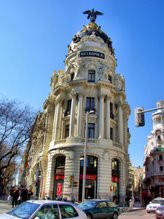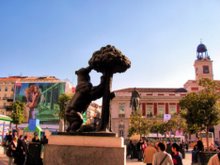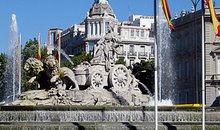However as soon as we got off the bus we shook our heads in disbelief wondering if an epic rock concert was taking place next door since there was a line of people going round the block. We crossed over the Paseo del Recoletos to find that the queue was indeed for the Impressionist exhibition. Certain art exhibits in Madrid have almost rock-star status and it's necessary to buy a ticket in advance to go (if it is a paid one) or to queue or go when the exhibit has been on for a long time. I remember I had to buy my Van Gogh ticket a week in advance for the exhibition two years ago a the Thyssen and I never managed to get into the Sorolla exhibit despite trying three times.
My flatmate and I looked at each other and discussed a contingency plan. Sitting in a bar or café was not a constructive thing to do so we thought we could try something else. The Prado is free on Sunday, so could try there. Again, a ruddy great queue. Lagrimas de Eros exhibition at the Thyssen? Good but I had already seen it and didn't particularly want to pay to see it again.
"What about the CaixaForum?" She said. I remembered having looked at the program and nothing caught my interest, but their exhibits are free and hence better than nothing. We walked on down the Paseo del Prado until we came to this post-modern art gallery funded by Spain's biggest bank.

The had 3 exhibitions on: one about Andrea Palladio - a famous Renaissance Italian architect, Hannah Collins - current History, and Maternities. I took one look at the Maternities brochure and recoiled in horror. I am not the kind of person who goes gaga over kids and motherhood is a concept which sends fear down my spine. Seeing an exhibition based on the gooey gagas of motherhood was not my idea for entertainment and at this point I was even considering paying for the Lagrimas de Eros exhibition again. My flatmate said "Come on - lets face our fears! Art is supposed to make you uncomfortable!" So we braced ourselves for the Maternities exhibition.

My honest opinion this exhibition generated no emotional reaction in me. The concept by photographer Bru Rovira wanted to show that love and family values could exist in any part of the world no matter how poor or devastated. Even reading the primary blurb made us look at each other and cringe "how corny". It's a concept that while noble has been overdone, almost a cliché now, but if the photography was good and had something to say it would be excused. The exhibition though was rather generic, and looked like they were photos which could have been pulled out of any National Geographic magazine. There would be a long blurb about the story behind the picture and you would look at the picture and it said nothing about the story. It was blank and devoid of a message. I would appreciate it if the message was conveyed, but it wasn't. The photos taken in Europe were more interesting because they were active, you could divulge a story from them. The others were bland.
The next exhibition was interesting: Hannah Collins - Current History. This was an exhibition split in 3 parts of photographic and video media about the life of the gypsies in Barcelona, life in Russia just after Communism and the journey of 3 African refugees to European countries projected on 3 screens. I thought this work was interesting, giving a snap shot of a life that most Europeans don't see. The gypsy one was fascinating as the film followed the life of this family in a slum outside Barcelona who lived a life total alien to what you would normally see. That their existence was based more in family and music and less about material comforts.

The Russian one was the weakest of the three parts. My flatmate found it too far removed from her culture and could not relate to it - just old guys walking staggering round the snow in fur hats drinking vodka. For me, while Russia and Hungary are very different countries, there were a lot of elements I recognised from living in Hungary just a couple of years after communism. If anything for me it seemed to familiar to be interesting to me.
The third section were 3 films shown side by side about African immigrants making their lives in Europe: One moved to London, one to Rome and one to Madrid. The Madrid one was the most interesting, talking about escaping Cameroon on a freight and trying to make a living in Madrid. This guy was homeless, but would wash his clothes in a bucket and leave them to dry in the sun. His appearance was smart as he tried to get legal status and a job in Spain. It was a rather moving piece and put a lot into perspective - that the little things we complain about in our luxurious lives are nothing compared to what other people suffer. It was not an exhibition I would go out of the way to see, but I am glad I did. It gave a lot of food for thought.

We wondered past the entrance for the Palladio exhibition and walked in to see it packed with people. We thought to give it a miss and do it another day, but soon realised that this was the last day for the exhibition. It looked interesting and was worth a skim at least. It chartered the work of architect Andrea Palladio through sketches, photographs and models. His influence on the neo-classical Renaissance style in Italy was very important. The exhibition was very cleverly laid and out and it was such a pity the previous two had saturated us a lot by this point. I am glad I gave it a quick skim.

The thing I like about the CaixaForum is that is gives a wide variety of art and through different media forms. The building itself is also worth having a gander at the architecture which is an interesting mix of cubism, modernism and post-modernism. The inclusion of vegetation into the architectural structure reminds me of the Austrian architect Friedensreich Hundertwasser who incorporated nature into his works.







No hay comentarios:
Publicar un comentario